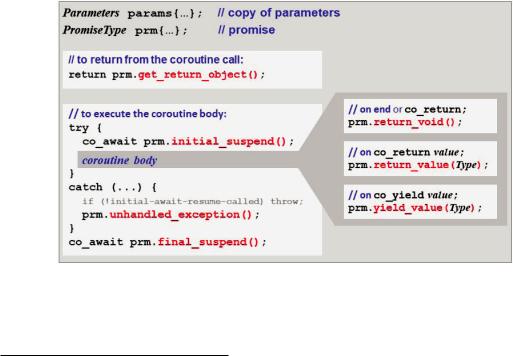
- •Contents
- •Preface
- •An Experiment
- •Acknowledgments
- •Versions of this Book
- •About This Book
- •What You Should Know Before Reading This Book
- •Overall Structure of the Book
- •The Way I Implement
- •Initializations
- •Error Terminology
- •The C++ Standards
- •Example Code and Additional Information
- •1 Comparisons and Operator <=>
- •1.1.1 Defining Comparison Operators Before C++20
- •1.1.2 Defining Comparison Operators Since C++20
- •1.2 Defining and Using Comparisons
- •1.2.2 Comparison Category Types
- •1.2.4 Calling Operator <=> Directly
- •1.2.5 Dealing with Multiple Ordering Criteria
- •1.3 Defining operator<=> and operator==
- •1.3.1 Defaulted operator== and operator<=>
- •1.3.2 Defaulted operator<=> Implies Defaulted operator==
- •1.3.3 Implementation of the Defaulted operator<=>
- •1.4 Overload Resolution with Rewritten Expressions
- •1.5 Using Operator <=> in Generic Code
- •1.5.1 compare_three_way
- •1.6 Compatibility Issues with the Comparison Operators
- •1.6.2 Inheritance with Protected Members
- •1.7 Afternotes
- •2 Placeholder Types for Function Parameters
- •2.1.1 auto for Parameters of Member Functions
- •2.2 Using auto for Parameters in Practice
- •2.3.1 Basic Constraints for auto Parameters
- •2.4 Afternotes
- •3.1 Motivating Example of Concepts and Requirements
- •3.1.1 Improving the Template Step by Step
- •3.1.2 A Complete Example with Concepts
- •3.2 Where Constraints and Concepts Can Be Used
- •3.2.1 Constraining Alias Templates
- •3.2.2 Constraining Variable Templates
- •3.2.3 Constraining Member Functions
- •3.3 Typical Applications of Concepts and Constraints in Practice
- •3.3.1 Using Concepts to Understand Code and Error Messages
- •3.3.2 Using Concepts to Disable Generic Code
- •3.3.3 Using Requirements to Call Different Functions
- •3.3.4 The Example as a Whole
- •3.3.5 Former Workarounds
- •3.4 Semantic Constraints
- •3.4.1 Examples of Semantic Constraints
- •3.5 Design Guidelines for Concepts
- •3.5.1 Concepts Should Group Requirements
- •3.5.2 Define Concepts with Care
- •3.5.3 Concepts versus Type Traits and Boolean Expressions
- •3.6 Afternotes
- •4.1 Constraints
- •4.2.1 Using && and || in requires Clauses
- •4.3 Ad-hoc Boolean Expressions
- •4.4.1 Simple Requirements
- •4.4.2 Type Requirements
- •4.4.3 Compound Requirements
- •4.4.4 Nested Requirements
- •4.5 Concepts in Detail
- •4.5.1 Defining Concepts
- •4.5.2 Special Abilities of Concepts
- •4.5.3 Concepts for Non-Type Template Parameters
- •4.6 Using Concepts as Type Constraints
- •4.7 Subsuming Constraints with Concepts
- •4.7.1 Indirect Subsumptions
- •4.7.2 Defining Commutative Concepts
- •5 Standard Concepts in Detail
- •5.1 Overview of All Standard Concepts
- •5.1.1 Header Files and Namespaces
- •5.1.2 Standard Concepts Subsume
- •5.2 Language-Related Concepts
- •5.2.1 Arithmetic Concepts
- •5.2.2 Object Concepts
- •5.2.3 Concepts for Relationships between Types
- •5.2.4 Comparison Concepts
- •5.3 Concepts for Iterators and Ranges
- •5.3.1 Concepts for Ranges and Views
- •5.3.2 Concepts for Pointer-Like Objects
- •5.3.3 Concepts for Iterators
- •5.3.4 Iterator Concepts for Algorithms
- •5.4 Concepts for Callables
- •5.4.1 Basic Concepts for Callables
- •5.4.2 Concepts for Callables Used by Iterators
- •5.5 Auxiliary Concepts
- •5.5.1 Concepts for Specific Type Attributes
- •5.5.2 Concepts for Incrementable Types
- •6 Ranges and Views
- •6.1 A Tour of Ranges and Views Using Examples
- •6.1.1 Passing Containers to Algorithms as Ranges
- •6.1.2 Constraints and Utilities for Ranges
- •6.1.3 Views
- •6.1.4 Sentinels
- •6.1.5 Range Definitions with Sentinels and Counts
- •6.1.6 Projections
- •6.1.7 Utilities for Implementing Code for Ranges
- •6.1.8 Limitations and Drawbacks of Ranges
- •6.2 Borrowed Iterators and Ranges
- •6.2.1 Borrowed Iterators
- •6.2.2 Borrowed Ranges
- •6.3 Using Views
- •6.3.1 Views on Ranges
- •6.3.2 Lazy Evaluation
- •6.3.3 Caching in Views
- •6.3.4 Performance Issues with Filters
- •6.4 Views on Ranges That Are Destroyed or Modified
- •6.4.1 Lifetime Dependencies Between Views and Their Ranges
- •6.4.2 Views with Write Access
- •6.4.3 Views on Ranges That Change
- •6.4.4 Copying Views Might Change Behavior
- •6.5 Views and const
- •6.5.1 Generic Code for Both Containers and Views
- •6.5.3 Bringing Back Deep Constness to Views
- •6.6 Summary of All Container Idioms Broken By Views
- •6.7 Afternotes
- •7 Utilities for Ranges and Views
- •7.1 Key Utilities for Using Ranges as Views
- •7.1.1 std::views::all()
- •7.1.2 std::views::counted()
- •7.1.3 std::views::common()
- •7.2 New Iterator Categories
- •7.3 New Iterator and Sentinel Types
- •7.3.1 std::counted_iterator
- •7.3.2 std::common_iterator
- •7.3.3 std::default_sentinel
- •7.3.4 std::unreachable_sentinel
- •7.3.5 std::move_sentinel
- •7.4 New Functions for Dealing with Ranges
- •7.4.1 Functions for Dealing with the Elements of Ranges (and Arrays)
- •7.4.2 Functions for Dealing with Iterators
- •7.4.3 Functions for Swapping and Moving Elements/Values
- •7.4.4 Functions for Comparisons of Values
- •7.5 New Type Functions/Utilities for Dealing with Ranges
- •7.5.1 Generic Types of Ranges
- •7.5.2 Generic Types of Iterators
- •7.5.3 New Functional Types
- •7.5.4 Other New Types for Dealing with Iterators
- •7.6 Range Algorithms
- •7.6.1 Benefits and Restrictions for Range Algorithms
- •7.6.2 Algorithm Overview
- •8 View Types in Detail
- •8.1 Overview of All Views
- •8.1.1 Overview of Wrapping and Generating Views
- •8.1.2 Overview of Adapting Views
- •8.2 Base Class and Namespace of Views
- •8.2.1 Base Class for Views
- •8.2.2 Why Range Adaptors/Factories Have Their Own Namespace
- •8.3 Source Views to External Elements
- •8.3.1 Subrange
- •8.3.2 Ref View
- •8.3.3 Owning View
- •8.3.4 Common View
- •8.4 Generating Views
- •8.4.1 Iota View
- •8.4.2 Single View
- •8.4.3 Empty View
- •8.4.4 IStream View
- •8.4.5 String View
- •8.4.6 Span
- •8.5 Filtering Views
- •8.5.1 Take View
- •8.5.2 Take-While View
- •8.5.3 Drop View
- •8.5.4 Drop-While View
- •8.5.5 Filter View
- •8.6 Transforming Views
- •8.6.1 Transform View
- •8.6.2 Elements View
- •8.6.3 Keys and Values View
- •8.7 Mutating Views
- •8.7.1 Reverse View
- •8.8 Views for Multiple Ranges
- •8.8.1 Split and Lazy-Split View
- •8.8.2 Join View
- •9 Spans
- •9.1 Using Spans
- •9.1.1 Fixed and Dynamic Extent
- •9.1.2 Example Using a Span with a Dynamic Extent
- •9.1.4 Example Using a Span with Fixed Extent
- •9.1.5 Fixed vs. Dynamic Extent
- •9.2 Spans Considered Harmful
- •9.3 Design Aspects of Spans
- •9.3.1 Lifetime Dependencies of Spans
- •9.3.2 Performance of Spans
- •9.3.3 const Correctness of Spans
- •9.3.4 Using Spans as Parameters in Generic Code
- •9.4 Span Operations
- •9.4.1 Span Operations and Member Types Overview
- •9.4.2 Constructors
- •9.5 Afternotes
- •10 Formatted Output
- •10.1 Formatted Output by Example
- •10.1.1 Using std::format()
- •10.1.2 Using std::format_to_n()
- •10.1.3 Using std::format_to()
- •10.1.4 Using std::formatted_size()
- •10.2 Performance of the Formatting Library
- •10.2.1 Using std::vformat() and vformat_to()
- •10.3 Formatted Output in Detail
- •10.3.1 General Format of Format Strings
- •10.3.2 Standard Format Specifiers
- •10.3.3 Width, Precision, and Fill Characters
- •10.3.4 Format/Type Specifiers
- •10.4 Internationalization
- •10.5 Error Handling
- •10.6 User-Defined Formatted Output
- •10.6.1 Basic Formatter API
- •10.6.2 Improved Parsing
- •10.6.3 Using Standard Formatters for User-Defined Formatters
- •10.6.4 Using Standard Formatters for Strings
- •10.7 Afternotes
- •11 Dates and Timezones for <chrono>
- •11.1 Overview by Example
- •11.1.1 Scheduling a Meeting on the 5th of Every Month
- •11.1.2 Scheduling a Meeting on the Last Day of Every Month
- •11.1.3 Scheduling a Meeting Every First Monday
- •11.1.4 Using Different Timezones
- •11.2 Basic Chrono Concepts and Terminology
- •11.3 Basic Chrono Extensions with C++20
- •11.3.1 Duration Types
- •11.3.2 Clocks
- •11.3.3 Timepoint Types
- •11.3.4 Calendrical Types
- •11.3.5 Time Type hh_mm_ss
- •11.3.6 Hours Utilities
- •11.4 I/O with Chrono Types
- •11.4.1 Default Output Formats
- •11.4.2 Formatted Output
- •11.4.3 Locale-Dependent Output
- •11.4.4 Formatted Input
- •11.5 Using the Chrono Extensions in Practice
- •11.5.1 Invalid Dates
- •11.5.2 Dealing with months and years
- •11.5.3 Parsing Timepoints and Durations
- •11.6 Timezones
- •11.6.1 Characteristics of Timezones
- •11.6.2 The IANA Timezone Database
- •11.6.3 Using Timezones
- •11.6.4 Dealing with Timezone Abbreviations
- •11.6.5 Custom Timezones
- •11.7 Clocks in Detail
- •11.7.1 Clocks with a Specified Epoch
- •11.7.2 The Pseudo Clock local_t
- •11.7.3 Dealing with Leap Seconds
- •11.7.4 Conversions between Clocks
- •11.7.5 Dealing with the File Clock
- •11.8 Other New Chrono Features
- •11.9 Afternotes
- •12 std::jthread and Stop Tokens
- •12.1 Motivation for std::jthread
- •12.1.1 The Problem of std::thread
- •12.1.2 Using std::jthread
- •12.1.3 Stop Tokens and Stop Callbacks
- •12.1.4 Stop Tokens and Condition Variables
- •12.2 Stop Sources and Stop Tokens
- •12.2.1 Stop Sources and Stop Tokens in Detail
- •12.2.2 Using Stop Callbacks
- •12.2.3 Constraints and Guarantees of Stop Tokens
- •12.3.1 Using Stop Tokens with std::jthread
- •12.4 Afternotes
- •13 Concurrency Features
- •13.1 Thread Synchronization with Latches and Barriers
- •13.1.1 Latches
- •13.1.2 Barriers
- •13.2 Semaphores
- •13.2.1 Example of Using Counting Semaphores
- •13.2.2 Example of Using Binary Semaphores
- •13.3 Extensions for Atomic Types
- •13.3.1 Atomic References with std::atomic_ref<>
- •13.3.2 Atomic Shared Pointers
- •13.3.3 Atomic Floating-Point Types
- •13.3.4 Thread Synchronization with Atomic Types
- •13.3.5 Extensions for std::atomic_flag
- •13.4 Synchronized Output Streams
- •13.4.1 Motivation for Synchronized Output Streams
- •13.4.2 Using Synchronized Output Streams
- •13.4.3 Using Synchronized Output Streams for Files
- •13.4.4 Using Synchronized Output Streams as Output Streams
- •13.4.5 Synchronized Output Streams in Practice
- •13.5 Afternotes
- •14 Coroutines
- •14.1 What Are Coroutines?
- •14.2 A First Coroutine Example
- •14.2.1 Defining the Coroutine
- •14.2.2 Using the Coroutine
- •14.2.3 Lifetime Issues with Call-by-Reference
- •14.2.4 Coroutines Calling Coroutines
- •14.2.5 Implementing the Coroutine Interface
- •14.2.6 Bootstrapping Interface, Handle, and Promise
- •14.2.7 Memory Management
- •14.3 Coroutines That Yield or Return Values
- •14.3.1 Using co_yield
- •14.3.2 Using co_return
- •14.4 Coroutine Awaitables and Awaiters
- •14.4.1 Awaiters
- •14.4.2 Standard Awaiters
- •14.4.3 Resuming Sub-Coroutines
- •14.4.4 Passing Values From Suspension Back to the Coroutine
- •14.5 Afternotes
- •15 Coroutines in Detail
- •15.1 Coroutine Constraints
- •15.1.1 Coroutine Lambdas
- •15.2 The Coroutine Frame and the Promises
- •15.2.1 How Coroutine Interfaces, Promises, and Awaitables Interact
- •15.3 Coroutine Promises in Detail
- •15.3.1 Mandatory Promise Operations
- •15.3.2 Promise Operations to Return or Yield Values
- •15.3.3 Optional Promise Operations
- •15.4 Coroutine Handles in Detail
- •15.4.1 std::coroutine_handle<void>
- •15.5 Exceptions in Coroutines
- •15.6 Allocating Memory for the Coroutine Frame
- •15.6.1 How Coroutines Allocate Memory
- •15.6.2 Avoiding Heap Memory Allocation
- •15.6.3 get_return_object_on_allocation_failure()
- •15.7 co_await and Awaiters in Detail
- •15.7.1 Details of the Awaiter Interface
- •15.7.2 Letting co_await Update Running Coroutines
- •15.7.3 Symmetric Transfer with Awaiters for Continuation
- •15.8.1 await_transform()
- •15.8.2 operator co_await()
- •15.9 Concurrent Use of Coroutines
- •15.9.1 co_await Coroutines
- •15.9.2 A Thread Pool for Coroutine Tasks
- •15.9.3 What C++ Libraries Will Provide After C++20
- •15.10 Coroutine Traits
- •16 Modules
- •16.1 Motivation for Modules Using a First Example
- •16.1.1 Implementing and Exporting a Module
- •16.1.2 Compiling Module Units
- •16.1.3 Importing and Using a Module
- •16.1.4 Reachable versus Visible
- •16.1.5 Modules and Namespaces
- •16.2 Modules with Multiple Files
- •16.2.1 Module Units
- •16.2.2 Using Implementation Units
- •16.2.3 Internal Partitions
- •16.2.4 Interface Partitions
- •16.2.5 Summary of Splitting Modules into Different Files
- •16.3 Dealing with Modules in Practice
- •16.3.1 Dealing with Module Files with Different Compilers
- •16.3.2 Dealing with Header Files
- •16.4 Modules in Detail
- •16.4.1 Private Module Fragments
- •16.4.2 Module Declaration and Export in Detail
- •16.4.3 Umbrella Modules
- •16.4.4 Module Import in Detail
- •16.4.5 Reachable versus Visible Symbols in Detail
- •16.5 Afternotes
- •17 Lambda Extensions
- •17.1 Generic Lambdas with Template Parameters
- •17.1.1 Using Template Parameters for Generic Lambdas in Practice
- •17.1.2 Explicit Specification of Lambda Template Parameters
- •17.2 Calling the Default Constructor of Lambdas
- •17.4 consteval Lambdas
- •17.5 Changes for Capturing
- •17.5.1 Capturing this and *this
- •17.5.2 Capturing Structured Bindings
- •17.5.3 Capturing Parameter Packs of Variadic Templates
- •17.5.4 Lambdas as Coroutines
- •17.6 Afternotes
- •18 Compile-Time Computing
- •18.1 Keyword constinit
- •18.1.1 Using constinit in Practice
- •18.1.2 How constinit Solves the Static Initialization Order Fiasco
- •18.2.1 A First consteval Example
- •18.2.2 constexpr versus consteval
- •18.2.3 Using consteval in Practice
- •18.2.4 Compile-Time Value versus Compile-Time Context
- •18.4 std::is_constant_evaluated()
- •18.4.1 std::is_constant_evaluated() in Detail
- •18.5 Using Heap Memory, Vectors, and Strings at Compile Time
- •18.5.1 Using Vectors at Compile Time
- •18.5.2 Returning a Collection at Compile Time
- •18.5.3 Using Strings at Compile Time
- •18.6.1 constexpr Language Extensions
- •18.6.2 constexpr Library Extensions
- •18.7 Afternotes
- •19.1 New Types for Non-Type Template Parameters
- •19.1.1 Floating-Point Values as Non-Type Template Parameters
- •19.1.2 Objects as Non-Type Template Parameters
- •19.2 Afternotes
- •20 New Type Traits
- •20.1 New Type Traits for Type Classification
- •20.1.1 is_bounded_array_v<> and is_unbounded_array_v
- •20.2 New Type Traits for Type Inspection
- •20.2.1 is_nothrow_convertible_v<>
- •20.3 New Type Traits for Type Conversion
- •20.3.1 remove_cvref_t<>
- •20.3.2 unwrap_reference<> and unwrap_ref_decay_t
- •20.3.3 common_reference<>_t
- •20.3.4 type_identity_t<>
- •20.4 New Type Traits for Iterators
- •20.4.1 iter_difference_t<>
- •20.4.2 iter_value_t<>
- •20.4.3 iter_reference_t<> and iter_rvalue_reference_t<>
- •20.5 Type Traits and Functions for Layout Compatibility
- •20.5.1 is_layout_compatible_v<>
- •20.5.2 is_pointer_interconvertible_base_of_v<>
- •20.5.3 is_corresponding_member()
- •20.5.4 is_pointer_interconvertible_with_class()
- •20.6 Afternotes
- •21 Small Improvements for the Core Language
- •21.1 Range-Based for Loop with Initialization
- •21.2 using for Enumeration Values
- •21.3 Delegating Enumeration Types to Different Scopes
- •21.4 New Character Type char8_t
- •21.4.2 Broken Backward Compatibility
- •21.5 Improvements for Aggregates
- •21.5.1 Designated Initializers
- •21.5.2 Aggregate Initialization with Parentheses
- •21.5.3 Definition of Aggregates
- •21.6 New Attributes and Attribute Features
- •21.6.1 Attributes [[likely]] and [[unlikely]]
- •21.6.2 Attribute [[no_unique_address]]
- •21.6.3 Attribute [[nodiscard]] with Parameter
- •21.7 Feature Test Macros
- •21.8 Afternotes
- •22 Small Improvements for Generic Programming
- •22.1 Implicit typename for Type Members of Template Parameters
- •22.1.1 Rules for Implicit typename in Detail
- •22.2 Improvements for Aggregates in Generic Code
- •22.2.1 Class Template Argument Deduction (CTAD) for Aggregates
- •22.3.1 Conditional explicit in the Standard Library
- •22.4 Afternotes
- •23 Small Improvements for the C++ Standard Library
- •23.1 Updates for String Types
- •23.1.1 String Members starts_with() and ends_with()
- •23.1.2 Restricted String Member reserve()
- •23.2 std::source_location
- •23.3 Safe Comparisons of Integral Values and Sizes
- •23.3.1 Safe Comparisons of Integral Values
- •23.3.2 ssize()
- •23.4 Mathematical Constants
- •23.5 Utilities for Dealing with Bits
- •23.5.1 Bit Operations
- •23.5.2 std::bit_cast<>()
- •23.5.3 std::endian
- •23.6 <version>
- •23.7 Extensions for Algorithms
- •23.7.1 Range Support
- •23.7.2 New Algorithms
- •23.7.3 unseq Execution Policy for Algorithms
- •23.8 Afternotes
- •24 Deprecated and Removed Features
- •24.1 Deprecated and Removed Core Language Features
- •24.2 Deprecated and Removed Library Features
- •24.2.1 Deprecated Library Features
- •24.2.2 Removed Library Features
- •24.3 Afternotes
- •Glossary
- •Index

15.2 The Coroutine Frame and the Promises |
507 |
15.2 The Coroutine Frame and the Promises
When a coroutine is started, three things happen:
•A coroutine frame is created to store all necessary data of the coroutine. This usually happens on the heap.
However, compilers are allowed to put the coroutine frame on the stack. This typically happens if the lifetime of the coroutine is within the lifetime of the caller and the compiler has enough information to compute the size of the frame.
• All parameters of the coroutine are copied into the frame.
Note that references are copied as references; it is not that their values are copied. This means that the arguments that the reference parameters refer to have to be valid as long as the coroutine is running.
The advice is to never declare coroutine parameters as references. Otherwise, fatal runtime errors with undefined behavior may occur.
•The promise object is created inside the frame. Its purpose is to store the state the coroutine and provide hooks for customization while the coroutine is running.
You can think of these objects as a “coroutine state controller” (an object that controls the behavior of the coroutine and can be used to track its state).2
Figure 15.1 visualizes this initialization and shows which customization points of the promise object are used while the coroutine is running.
Figure 15.1. Coroutine frame and promise
2Thanks to Lewis Baker for pointing this out in http://lewissbaker.github.io/2018/09/05/understanding-the-promise-type.

508 |
Chapter 15: Coroutines in Detail |
15.2.1 How Coroutine Interfaces, Promises, and Awaitables Interact
Let us also bring the awaitables into play again and see how work as a whole is organized:
•For each coroutine started, the compiler creates a promise.
•That promise, embedded in a coroutine handle, is then placed in a coroutine interface. That is, the coroutine interface usually controls the lifetime of the handle and its promise.
•On suspension, coroutines use awaitables to control what happens on suspension and resumption.
The following program demonstrates the exact control flow by using a tracing coroutine interface, promise, and awaiter. The tracing coroutine interface and promise are implemented as follows:
coro/tracingcoro.hpp |
|
|
#include |
<iostream> |
|
#include |
<coroutine> |
|
#include |
<exception> |
// for terminate() |
//coroutine interface to deal with a simple task
//- providing resume() to resume it
class [[nodiscard]] TracingCoro { public:
// native coroutine handle and its promise type: struct promise_type;
using CoroHdl = std::coroutine_handle<promise_type>;
CoroHdl hdl; |
// coroutine handle |
// helper type for state and customization: |
|
struct promise_type { |
|
promise_type() { |
|
std::cout << " |
PROMISE: constructor\n"; |
} |
|
~promise_type() { |
|
std::cout << " |
PROMISE: destructor\n"; |
}
auto get_return_object() { // init and return the coroutine interface std::cout << " PROMISE: get_return_object()\n";
return TracingCoro{CoroHdl::from_promise(*this)};
} |
|
|
auto initial_suspend() { |
// initial suspend point |
|
std::cout << " |
PROMISE: initial_suspend()\n"; |
|
return std::suspend_always{}; |
// - start lazily |
|
} |
|
|
void unhandled_exception() { |
// deal with exceptions |
|
std::cout << " |
PROMISE: unhandled_exception()\n"; |
|
std::terminate(); |
|
// - terminate the program |
} |
|
|

15.2 The Coroutine Frame and the Promises
void return_void() { |
|
// deal with the end or co_return; |
std::cout << " |
PROMISE: return_void()\n"; |
|
} |
|
|
auto final_suspend() noexcept { |
// final suspend point |
|
std::cout << " |
PROMISE: final_suspend()\n"; |
|
return std::suspend_always{}; |
// - suspend immediately |
|
} |
|
|
};
// constructor and destructor:
TracingCoro(auto h)
: hdl{h} { // store coroutine handle in interface std::cout << " INTERFACE: construct\n";
}
~TracingCoro() {
std::cout << " INTERFACE: destruct\n"; if (hdl) {
hdl.destroy(); // destroy coroutine handle
}
}
// don’t copy or move:
TracingCoro(const TracingCoro&) = delete; TracingCoro& operator=(const TracingCoro&) = delete;
//API to resume the coroutine
//- returns whether there is still something to process
};
bool resume() const { |
|
std::cout << " |
INTERFACE: resume()\n"; |
if (!hdl || hdl.done()) { |
|
return false; |
// nothing (more) to process |
} |
|
hdl.resume(); |
// RESUME |
return !hdl.done(); |
|
} |
|
We trace:
•When the coroutine interface is initialized and destroyed
•When the coroutine interface resumes the coroutine
•Each promise operation
509

510 |
Chapter 15: Coroutines in Detail |
The tracing awaiter is implemented as follows: coro/tracingawaiter.hpp
#include <iostream>
class TracingAwaiter {
inline static int maxId = 0; int id;
public:
TracingAwaiter() : id{++maxId} {
std::cout << " AWAITER" << id << ": ==> constructor\n";
}
~TracingAwaiter() {
std::cout << " AWAITER" << id << ": <== destructor\n";
}
// don’t copy or move:
TracingAwaiter(const TracingAwaiter&) = delete; TracingAwaiter& operator=(const TracingAwaiter&) = delete;
// constexpr
bool await_ready() const noexcept {
std::cout << " AWAITER" << id << ": await_ready()\n"; return false; // true: do NOT (try to) suspend
}
//Return type/value means:
//- void: do suspend
//- bool: true: do suspend
//- handle: resume coro of the handle
//constexpr
bool await_suspend(auto) const noexcept {
std::cout << " AWAITER" << id << ": await_suspend()\n"; return false;
}
// constexpr
void await_resume() const noexcept {
std::cout << " AWAITER" << id << ": await_resume()\n";
};}
Here, we also trace each operation.
Note that the member functions cannot be constexpr because they have I/O.

15.2 The Coroutine Frame and the Promises |
511 |
|
|
|
The coroutine is implemented and used as follows: |
|
|
|
|
coro/corotrace.cpp |
|
|
|
|
#include "tracingcoro.hpp" |
|
|
|
|
|
|
|
|
|
#include "tracingawaiter.hpp" |
|
|
|
|
#include <iostream> |
|
|
|
|
TracingCoro coro(int max) |
|
|
|
|
{ |
|
|
|
|
std::cout << " |
START coro(" << max << ")\n"; |
|
||
for (int i = 1; i <= max; ++i) { |
|
|
|
|
std::cout << " |
CORO: " << i << '/' << max << '\n'; |
|
||
co_await TracingAwaiter{}; |
// SUSPEND |
|
||
std::cout << " |
CONTINUE coro(" << max << ")\n"; |
|
||
} |
|
|
|
|
std::cout << " |
END coro(" << max << ")\n"; |
|
||
} |
|
|
|
|
int main() |
|
|
|
|
{ |
|
|
|
|
// start coroutine: |
|
|
|
|
std::cout << "**** start coro()\n"; |
|
|
|
|
auto coroTask = coro(3); |
// init coroutine |
|
||
std::cout << "**** coro() started\n"; |
|
|
|
|
// loop to resume the coroutine until it is done: |
|
|
|
|
std::cout << "\n**** resume coro() in loop\n"; |
|
|||
while (coroTask.resume()) { |
// RESUME |
|
||
std::cout << "**** coro() suspended\n"; |
|
|||
... |
|
|
|
|
std::cout << "\n**** resume coro() in loop\n"; |
|
|||
} |
|
|
|
|
std::cout << "\n**** coro() loop done\n"; |
|
|||
} |
|
|
|
|
The program has the following output: |
|
|
||
|
|
|||
**** start coro()
PROMISE: constructor PROMISE: get_return_object()
INTERFACE: construct PROMISE: initial_suspend()
****coro() started
****resume coro() in loop INTERFACE: resume()
512 |
Chapter 15: Coroutines in Detail |
START coro(3)
CORO: 1/3
AWAITER1: ==> constructor
AWAITER1: await_ready()
AWAITER1: await_suspend()
****coro() suspended
****resume coro() in loop INTERFACE: resume()
AWAITER1: await_resume()
AWAITER1: <== destructor
CONTINUE coro(3)
CORO: 2/3
AWAITER2: ==> constructor
AWAITER2: await_ready()
AWAITER2: await_suspend()
****coro() suspended
****resume coro() in loop INTERFACE: resume()
AWAITER2: await_resume()
AWAITER2: <== destructor
CONTINUE coro(3)
CORO: 3/3
AWAITER3: ==> constructor
AWAITER3: await_ready()
AWAITER3: await_suspend()
****coro() suspended
****resume coro() in loop INTERFACE: resume()
AWAITER3: await_resume()
AWAITER3: <== destructor
CONTINUE coro(3)
END coro(3)
PROMISE: return_void()
PROMISE: final_suspend()
**** coro() loop done INTERFACE: destruct
PROMISE: destructor
The first thing that happens when we call a coroutine is that the coroutine promise is created.
Then, get_return_object() is called for the promise created. This function usually initializes the coroutine handle and returns the coroutine interface initialized with it. To create the handle, usually the static member function from_promise() is called. The handle is then passed to initialize the coroutine interface of the type TracingCoro. The coroutine interface is then returned to the caller of get_return_object() so that it can be used as the return value of the call of the coroutine (in rare cases other return types are possible).
Then, initial_suspend() is called to see whether the coroutine should be immediately suspended (start lazily), which is the case here. Therefore, the control flow is given back to the caller of the coroutine.
15.2 The Coroutine Frame and the Promises |
513 |
Later, main() calls resume(), which calls resume() for the coroutine handle. This call resumes the coroutine, which means that the coroutine processes the following statements up to the next suspension or its end.
With each suspension, co_await uses an awaitable, which is an awaiter of the type TracingAwaiter in this case. It is created with the default constructor. For the awaiter, the member functions await_ready() and await_suspend() are called to control the suspension (they might even reject it). Because await_ready() returns false and await_suspend() returns nothing, the request to suspend is accepted. Therefore, the resumption of the coroutine ends and main() continues. On the next resumption, await_resume() is called and the coroutine continues.
When a coroutine reaches its end or a co_return statement, the corresponding member functions for dealing with its end are called. First, depending on whether or not there is a return value, return_void() or return_value() is called. Then, the function for the final suspension, final_suspend(), is called. Note that even inside final_suspend() the coroutine is still “running,” which means that calling resume() again or destroy() inside final_suspend() would cause a runtime error.
At the end of the lifetime of the coroutine interface, its destructor is called, which destroys the coroutine handle. Finally, the promise is destroyed.
As an alternative, assume that initial_suspend() returns a promise type signaling to start the coroutine eagerly instead of initially suspending it:
class [[nodiscard]] TracingCoro { |
|
|
public: |
|
|
... |
|
|
struct promise_type { |
|
|
... |
|
|
auto initial_suspend() { |
// initial suspend point |
|
std::cout << " |
PROMISE: initial_suspend()\n"; |
|
return std::suspend_never{}; |
// - start eagerly |
|
} |
|
|
... |
|
|
};
...
};
In this case, we would get the following output:
**** start coro()
PROMISE: constructor PROMISE: get_return_object()
INTERFACE: construct PROMISE: initial_suspend()
START coro(3) CORO: 1/3
AWAITER1: ==> constructor AWAITER1: await_ready() AWAITER1: await_suspend()
****coro() started
****resume coro() in loop INTERFACE: resume()
514 |
Chapter 15: Coroutines in Detail |
AWAITER1: await_resume()
AWAITER1: <== destructor
CONTINUE coro(3)
CORO: 2/3
AWAITER2: ==> constructor
AWAITER2: await_ready()
AWAITER2: await_suspend()
****coro() suspended
****resume coro() in loop
INTERFACE: resume()
AWAITER2: await_resume()
AWAITER2: <== destructor
CONTINUE coro(3)
CORO: 3/3
AWAITER3: ==> constructor
AWAITER3: await_ready()
AWAITER3: await_suspend()
****coro() suspended
****resume coro() in loop INTERFACE: resume()
AWAITER3: await_resume()
AWAITER3: <== destructor
CONTINUE coro(3)
END coro(3)
PROMISE: return_void()
PROMISE: final_suspend()
**** coro() loop done INTERFACE: destruct
PROMISE: destructor
Again, the coroutine framework creates the promise and calls get_return_object() for it, which initializes the coroutine handle and the coroutine interface. However, initial_suspend() does not suspend. Therefore, the coroutine starts eagerly executing the first statements until the first co_await suspends it for the first time. This suspension is the moment when the TracingCoro object that initially was created in get_return_object() is returned to the caller of the coroutine. After that, as before, we loop over the resumptions.
